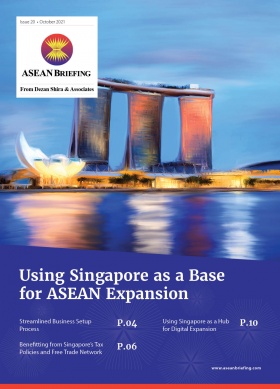The Cambodia-South Korea Free Trade Agreement: Increasing Potential for Downstream Sectors
The Cambodia-South Korea Free Trade Agreement can help boost Cambodian exports of garments, textiles, and footwear to South Korea. The agreement also presents opportunities for value-added investments in Cambodia’s downstream processing industries through a ‘plus one business model’, in which South Korean companies could expand their supply chain network developed in not only China but also Vietnam or Thailand.
The Cambodia-Korea Free Trade Agreement (CKFTA) was signed into law in Cambodia in January 2022 and is expected to be ratified by June 2022.
The CKFTA should boost trade between the two countries with South Korea agreeing to remove tariffs on 95.6 percent of products imported from Cambodia while Cambodia will eliminate duties on 93.8 percent of imported goods.
Cambodia-South Korea bilateral trade was valued at US$885 million in 2020 and grew by nine percent to US$965 million in 2021 (bilateral trade had reached over US$1 billion before the pandemic). Further, Cambodia imported over US$600 million from South Korea in 2021 while exports reached US$341 million to the East Asian nation.
Meanwhile, the CKFTA falls under South Korea’s ‘New Southern Policy’. The policy, is considered to be Seoul’s first unified diplomatic initiative and aims to advance relations with ASEAN and India.
Cambodia looking to diversify its economy away from garments, textiles, and tourism
In addition to increasing trade, Cambodia is hoping South Korean firms can help diversify its economy away from its mainstays of garment and textile manufacturing, and tourism.
Garment and textile manufacturing make up some 80 percent of Cambodia’s exports, contributes to 30 percent of GDP, and employs over 800,000 workers nationwide. The tourism industry contributes 12 percent of GDP. The government plans to increase non-textile and garment exports to 15 percent as well as processed agricultural goods to 12 percent by 2025.
There are more than 300 South Korean manufacturing firms in Cambodia that are mostly operating in the light manufacturing industry, producing goods such as clothing, footwear, travel bags, and footwear.
Cambodia exports raw agricultural products including rubber, fruits and starches to South Korea as well as electrical and electronic components. Cambodia relies on South Korea for more advanced electronic and assembled goods that require highly developed technology.
Electronics and automotive manufacturing
Although electronics constitute a small portion of Cambodia’s exports to South Korea (approximately US$35 million), Cambodia’s government has identified the electronics and automotive industries as priority industries that will help promote the country in the global value chain.
Cambodia has the potential to become an automotive and electronic component production hub and complement its neighbors, Thailand and Vietnam, who have well-established automotive and electronic manufacturing centers respectively. The country’s strategic location along the Mekong Delta — a subregion that is attracting interest from foreign investors who are taking advantage of the pace of increased intra-regional integration — is helping Cambodia to become an alternative supply base for electronic and automotive spare parts for factories in Thailand and Vietnam.
Agro-processing
Creating added value in the agriculture sector is one strategy the government is banking on to diversify Cambodia’s economy. The country’s flat terrain and access to vast water sources mean agriculture holds considerable potential for development.
Cambodia exports agricultural products to over 68 countries, which generated gross revenue of US$4.68 billion in 2021. The main raw products that are exported are rice, rubber, tobacco, mangoes, bananas, corn, pepper, palm oil, and cashew nuts. Through the FTA, Cambodia is seeking to increase the export value, especially for more value-added agricultural products.
Increasing Cambodia’s agro-processing capacity can connect the sector to more value chains. For instance, the country exports over 600,000 tons of rice annually. However, more potential opportunities exist by processing the rice for other products like noodles.The Cambodia agriculture sector is currently highly fragmented and dominated by smallholders. The industry poses significant challenges in areas like maintaining quality standards and policies to support efficiency among small and medium farmers.
Ongoing reforms in Cambodia to help spur foreign investments
South Korean investors will have confidence in the ongoing pro-business reforms Cambodia has enacted over the past year.
The Law on Investment, issued in October 2021, provided 19 selected industries with investment incentives. These incentives range from income tax exemption, the deduction of capital expenditure through a special depreciation mechanism, and the exemption for export custom duties. In addition, eligible businesses can also receive value-added tax exemptions for the import of construction equipment, production inputs, and production equipment, among others.
The Cambodian government has also made attempts to improve the overall labor environment by introducing a new pension scheme and making amendments to the Labor Law.
Under the new pension scheme, four new types of social benefits have now been introduced for workers. These are:
- Old-age pension;
- Disability pension;
- Survivor’s pension; and
- Funeral allowance.
Meanwhile, the amendments to the Labor Law include allowing businesses to schedule working hours into three shifts, and labor disputes can now be brought to court if the disputing parties cannot resolve the issues amicably.
The government hopes these changes can strengthen Cambodia’s competitiveness and help reach its target of becoming a middle-income nation by 2030 and a high-income nation by 2050.
Further Reading
- Cambodia’s First Law on Competition: What Investors Need to Know
- Cambodia Makes Amendments to the Labor Law
- Cambodia Introduces New Pension Scheme
About Us
ASEAN Briefing is produced by Dezan Shira & Associates. The firm assists foreign investors throughout Asia and maintains offices throughout ASEAN, including in Singapore, Hanoi, Ho Chi Minh City, and Da Nang in Vietnam, Munich, and Essen in Germany, Boston, and Salt Lake City in the United States, Milan, Conegliano, and Udine in Italy, in addition to Jakarta, and Batam in Indonesia. We also have partner firms in Malaysia, Bangladesh, the Philippines, and Thailand as well as our practices in China and India. Please contact us at asia@dezshira.com or visit our website at www.dezshira.com.







